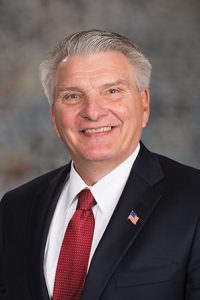Bill seeks to address university deferred maintenance needs
The University of Nebraska would have more tools to address facilities maintenance under a bill considered Feb. 16 by the Appropriations Committee.

LB588, introduced by Gering Sen. John Stinner, would extend existing appropriations for deferred maintenance under the University of Nebraska Facilities Program until 2062 and the State College Facilities Program until 2040.
Stinner said the university currently is facing nearly $800 million in deferred maintenance for existing structures. The nearly 1,000 buildings owned by the university system are important state assets that require modernization and a long-term maintenance plan, he said.
“As part of our effort to produce and educate a workforce, these [facilities] are a key economic driver for the state,” Stinner said. “Interest rates are at a historical low and the cost of capital presents a unique opportunity to help the university and state colleges maximize state funds and solve this problem.”
The bill also would increase the university’s annual appropriation by $2.5 million – to be matched by the university — to renew, renovate, replace or repair existing facilities. The bill would require that the university establish a revolving facility maintenance fund with a 2 percent allocation of all construction funds expended to mitigate further backlog.
“This oversight is critical to the Legislature’s ability to determine whether funds are being expended strategically and in concert with statewide needs and priorities,” Stinner said.
Ted Carter, president of the University of Nebraska, testified in support of the proposal. He said that most colleges and universities are dealing with rapidly aging infrastructure. More than one-third of the University of Nebraska’s buildings are at least 50 years old, he said — the result of a building boom in the 1960s and ‘70s — and are nearing the end of their natural lives.
Without LB588, Carter said, the price tag for deferred facility maintenance would grow to $2.3 billion by 2062. Taking advantage of historically low interest rates would save the state $1.5 billion over the next 40 years, he added, and would ensure world-class facilities for students and faculty.
“I’m often asked ‘what are the issues that keep you up at night?’” Carter said. “Many nights, it’s the state of our physical plant. I consider facilities to be a crucial part of our recruitment and retention strategy.”
Bob Phares, member of the University of Nebraska Board of Regents, also testified in support. He noted that last winter the steam tunnel that provides heat to the residence halls at the Nebraska College of Technical Agriculture in Curtis suddenly collapsed.
“We can’t allow students to go without heat,” he said. “Deferred maintenance is a real issue. The administration has done good work, but it is clear to me after 15 years that we’re not going to solve this whole problem without a bolder, longer-term plan.”
Veronica Miller of Crete, University of Nebraska-Lincoln student body president and student regent, also testified in support. Speaking on behalf of the university system’s 52,000 students, she said facilities are an important part of keeping the University of Nebraska competitive.
“We attend different campuses, we are in hundreds of different areas of study and we all spend our time on campus in different ways,” Miller said. “What we have in common, though, is a desire for safe, modern, high-quality buildings where we can learn, study and grow.”
No one testified against LB588 and the committee took no immediate action on the bill.

